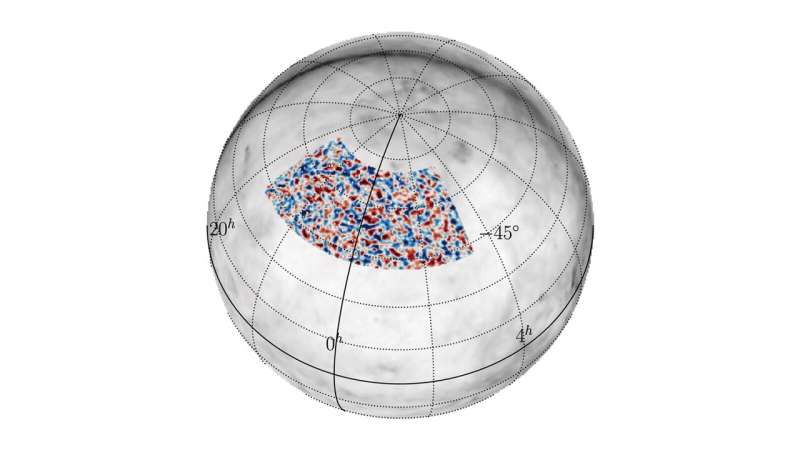For more than five years, scientists at the South Pole Telescope in Antarctica have been observing the sky with an upgraded camera. The extended gaze toward the cosmos is picking up remnant light from the universe’s early formation. Now researchers have analyzed an initial batch of data, publishing details in the journal Physical Review D. The results from this limited dataset hint at even more powerful future insights about the nature of our universe.
The telescope at the Amundsen-Scott South Pole Station, which is operated by the National Science Foundation, received a new camera known as SPT-3G in 2017. Equipped with 16,000 detectors—10 times more than its predecessor—the SPT-3G is central to multi-institutional research led in part by the U.S. Department of Energy’s (DOE) Argonne National Laboratory. The goal is to measure faint light known as the cosmic microwave background (CMB). The CMB is the afterglow of the Big Bang, when the universe burst forth from a single point of energy nearly 14 billion years ago.
“The CMB is a treasure map for cosmologists,” said Zhaodi Pan, the paper’s lead author and a Maria Goeppert Mayer fellow at Argonne. “Its minuscule variations in temperature and polarization provide a unique window into the universe’s infancy.”
The paper in Physical Review D offers the first CMB gravitational lensing measurements from the SPT-3G. Gravitational lensing happens when the universe’s vast web of matter distorts the CMB as it travels across space. If you were to place the curved base of a wine glass on the page of a book, the glass would warp your view of the words behind it. Similarly, matter in the telescope’s line of sight forms a lens that bends the CMB light and our view of it. Albert Einstein described this warping in the fabric of space-time in his theory of general relativity.
Measurements of that distortion hold clues about the early universe and mysteries like dark matter, an invisible component of the cosmos. “Dark matter is tricky to detect, because it doesn’t interact with light or other forms of electromagnetic radiation. Currently, we can only observe it through gravitational interactions,” Pan said.
Scientists have been studying the CMB ever since it was discovered in the 1960s, observing it through telescopes both on the ground and in space. Even though the newest analysis uses only a few months of SPT-3G data from 2018, the measurement of gravitational lensing is already competitive in the field.
“One of the really exciting parts of this study is that the result comes from what’s essentially commissioning data from when we were just beginning observations with the SPT-3G—and the result is already great,” said Amy Bender, a physicist at Argonne and paper co-author. “We’ve got five more years of data that we’re working on analyzing now, so this just hints at what’s to come.”

The dry, stable atmosphere and remote location of the South Pole Telescope create as little interference as possible when hunting for CMB patterns. Still, data from the highly sensitive SPT-3G camera contains contamination from the atmosphere, as well as from our own galaxy and extragalactic sources.
Analyzing even a few months of data from SPT-3G is an undertaking that lasts years, since researchers need to validate data, filter out noise and interpret measurements. The team used a dedicated cluster, a group of computers, at the Argonne Laboratory Computing Resource Center to run some of the calculations for the research.
“We found that the observed lensing patterns in this study are well explained by general relativity,” Pan said. “This suggests that our current understanding of gravity holds true for these large scales. The results also strengthen our existing understanding of how structures of matter formed in our universe.”
SPT-3G lensing maps from additional years of data will also help in probing cosmic inflation, or the idea that the early universe underwent a fast exponential expansion. Cosmic inflation is “another cornerstone of cosmology,” Pan noted, and scientists are hunting for signs of early gravitational waves and other direct evidence of this theory. The presence of gravitational lensing introduces interference with inflationary imprints, necessitating the removal of such contamination, which can be calculated using precise lensing measurements.
While some results from the new SPT-3G data will reinforce existing knowledge, others will raise new questions.
“Every time we add more data, we find more things that we don’t understand,” Bender said who holds a joint appointment at the University of Chicago. “As you peel back layers of this onion, you learn more and more about your instrument and also about your scientific measurement of the sky.”
So little is known about the universe’s unseen components that any understanding gained is critical, Pan said, “The more we learn about the distribution of dark matter, the closer we get to understanding its nature and its role in forming the universe that we live in today.”
More information:
Z. Pan et al, Measurement of gravitational lensing of the cosmic microwave background using SPT-3G 2018 data, Physical Review D (2023). DOI: 10.1103/PhysRevD.108.122005
Provided by
Argonne National Laboratory
Citation:
Results from South Pole Telescope’s new camera emerge (2024, February 8)
retrieved 11 February 2024
from
This document is subject to copyright. Apart from any fair dealing for the purpose of private study or research, no
part may be reproduced without the written permission. The content is provided for information purposes only.